M-26 Pershing – Heavy Late WW2 Tank
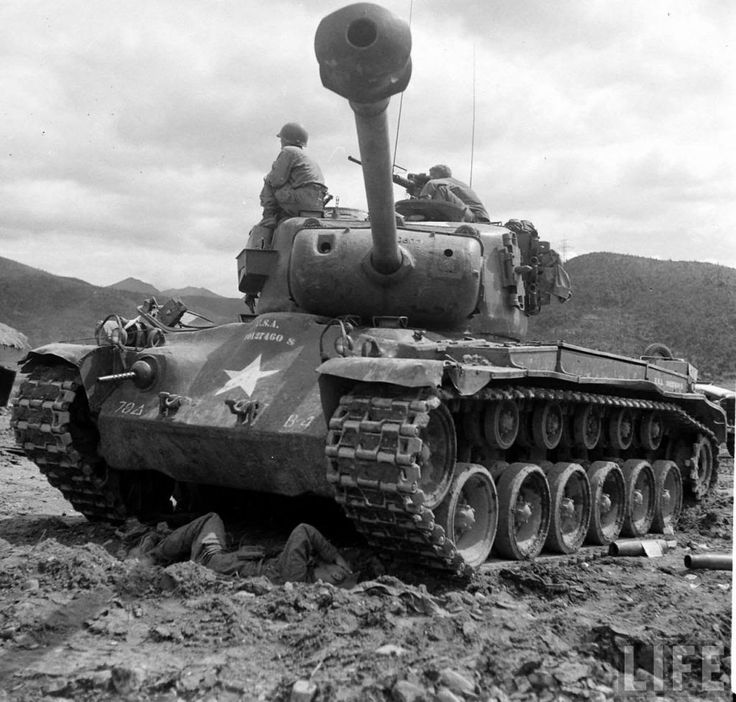
M26 Pershing in WW2
M-26 Pershing”- Named in honor of General John Pershing , who led the American Expeditionary Force during the First World War. Developed as a replacement for the M4 Sherman. From February 1945, ershing tanks took part in World War II ; and in 1950-1951 it participated in the Korean War.
Just like the armies of other countries at the time, the US army envisaged the use of tanks for two main purposes: supporting infantry and breaking through enemy fortifications. From 1942 until the end of World War II, the M4 Sherman tank was used for two purposes ., which was mostly a “cavalry” tank. Meanwhile, the infantry would have preferred to have a tank that was more armored and more powerfully armed, even if at the expense of reduced driving performance. Therefore, in the fall of 1942, the US Army’s weapons service began to develop a project for an “infantry-oriented tank”, whose design would be more versatile than that of British infantry tanks. The main task of the project was to create a tank with a combat weight not exceeding 32 tons, 75 mm. cannon, frontal armor of at least 100 mm and a speed of at least 40 km / h. Over the next two years, various prototypes were created: T20, T22, T23, T25 and T26. They used various options for weapons, transmissions and suspensions.
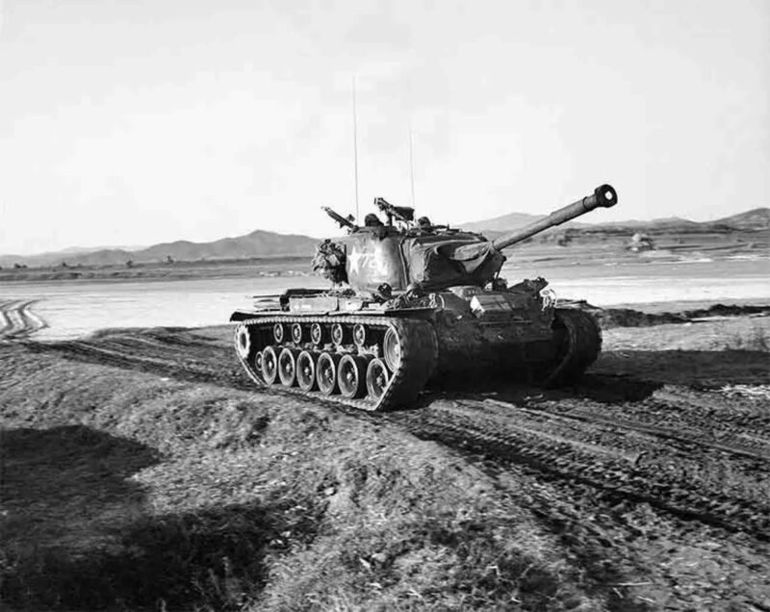
The electric transmission developed by General Electric was tested on the T23. The electrical system was too heavy, so the developers settled on a hydraulic transmission with a torque converter from General Motors . The creators also experimented with the auto-charging mechanism, but it turned out to be unreliable and had to be abandoned. The engine chosen was a new Ford gasoline engine designed specifically for tanks. The powerful new engine allowed the latest model to reach a highway speed of 48 km / h. A torsion bar suspension was also used for the new tank. The M26 received six road wheels and five track rollers. Unlike M24 Chaffee, on the M26 the drive wheel was located at the rear.
The result of the project was the creation of the T26E1 model at the beginning of 1944. The T26E1 tank had a 90 mm gun, 100 mm frontal armor and a weight of 43.25 tons, which was 8.5 tons more than the M4 tank .
However, under the influence of the initial, relatively successful use of the Sherman tank, the Army Command got the impression that there was no urgent need to develop a new tank. Even with the appearance of heavy tanks ” Tiger ” and ” Panther ” in Germany, the opinion of the American command did not change, since they believed that the new vehicles would not be found in large numbers with German troops. With regard to the “Tigers”, the command’s assumption was correct: on the Western Front, these machines were really rare. However, the Panthers, with which the allies first met at Anzio , began to be produced in large quantities. Tanks of this type made up half of the German tank power in Normandy…. In addition, according to the army doctrine of the time, tanks were not created to fight other tanks. For these purposes, tank destroyers were used – more mobile armored vehicles, such as the M10 “Wolverine” . For all these reasons, the design of the new tank went very slowly.
At the time of the Allied invasion of Western Europe during the Normandy landings in July 1944, Sherman tanks made up the overwhelming majority of their tank fleet. It soon became clear that the doctrine of using tank destroyers was wrong, and that the Sherman tanks could not fight the Panthers on equal terms. Efforts were made to accelerate ongoing development, but the tank, now called the Pershing, did not appear on the battlefield until February 1945 (the first battle on February 25 near the Ruhr River) and took a relatively modest role in World War II. After the baptism of fire, the T26E3 tank was renamed M26.
The Pershing was originally designed as a medium tank, but at the end of 1944 it was reclassified as heavy to boost the confidence of the crews. In May 1946 , in connection with the changed American concept of tank forces, “Pershing” was again reclassified into a medium tank. Hence some of its features: in comparison with the average Sherman, the Pershing was a significant step forward, especially in the field of weapons and armor protection. However, its cross-country ability did not match the cross-country ability of a medium tank, due to the fact that the M26 had the same engine as the M4A3, while the M4A3 was lighter than the Pershing by about ten tons. The M26 transmission was also not entirely reliable, this deficiency was eliminated in 1948.with the advent of a new modification, the M26E2, which used a new power plant. This new modification was named M46 “General Patton” . The M26 th 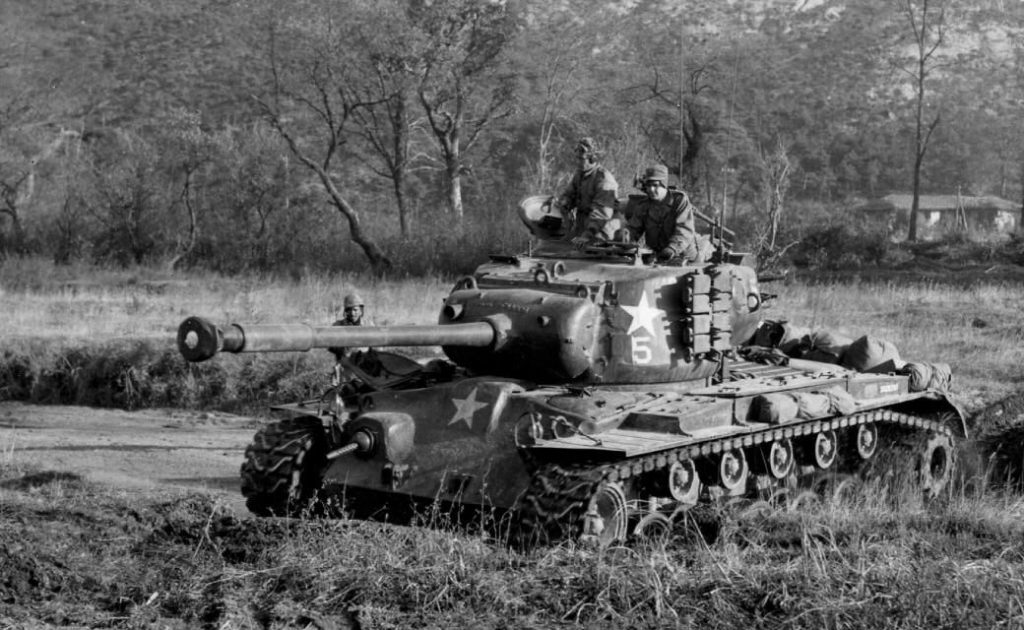 hull itself was changed – by increasing the angle of inclination from 42 to 60 degrees, and was an emergency measure in an attempt to cheaply and quickly create a temporary replacement for the rapidly aging M46 until a full-fledged new tank, and the M48 and M60 tanks were already fundamentally new developments.
hull itself was changed – by increasing the angle of inclination from 42 to 60 degrees, and was an emergency measure in an attempt to cheaply and quickly create a temporary replacement for the rapidly aging M46 until a full-fledged new tank, and the M48 and M60 tanks were already fundamentally new developments.
Combat use
The Second World War
The M26 was in development for a long time, so it got to the war at the very end. A small number of these tanks were transferred to General Omar Bradley’s 12th Army Group and distributed between the 3rd and 9th Panzer Divisions. The tanks took their first battle in February 1945. The first recorded loss of the Pershing tank occurred on February 28 – one tank was hit by the German Tiger, but was later repaired.
Belton Cooper, a wartime weapons officer in the combat command of the 3rd Panzer Division, recalls the Pershing in his memoir. According to him, ten Pershing tanks arrived in the 3rd Panzer Division in early February 1945. Cooper argues that these tanks could have arrived there earlier if not for opposition from General George Patton , who preferred Sherman tanks. Patton explained his preference by the fact that the Sherman consumes less fuel and has better driving characteristics than the Pershing. At the time, to which Patton’s objections refer, the relative weakness of the Sherman’s weapons and its insufficient armor protection were not yet so obvious.
The Korean War
Pershing tanks also took part in the Korean War, although relatively few tanks were sent there, as the commanders reported from the front: “Korea is a country not very suitable for tanks.” The official history of the US Army even claims that some of the Pershing tanks were removed from the pedestals in Fort Knox, where they served as memorials of the Second World War for the sake of this. A total of 309 Pershing tanks were dispatched from August 10, 1950 to January 10, 1951. During the war, M26 tanks destroyed 29 North Korean T-34-85s. According to American data, the North Korean “thirty-fours” managed to knock out 6 “Pershing”. From July 1950 to January 21, 1951, 252 Pershing tanks were involved in the 1st, 9th and 10th Army Corps, of which 156 tanks were disabled, including 50 tanks were completely destroyed or captured… From January 21 to October 6, 1951, 170 M26 tanks were disabled, the irrecoverable part is unknown. In the subsequent period, the losses are unknown.
On the Pershing, the crew of Sergeant E. Kouma performed their feat , destroying over 250 North Korean soldiers in a 9-hour battle.
Due to the low efficiency of application in mountainous conditions (500 hp engine as on the 30-ton M4A3 ) in 1951 all Pershing were replaced by Shermans and Pattons.
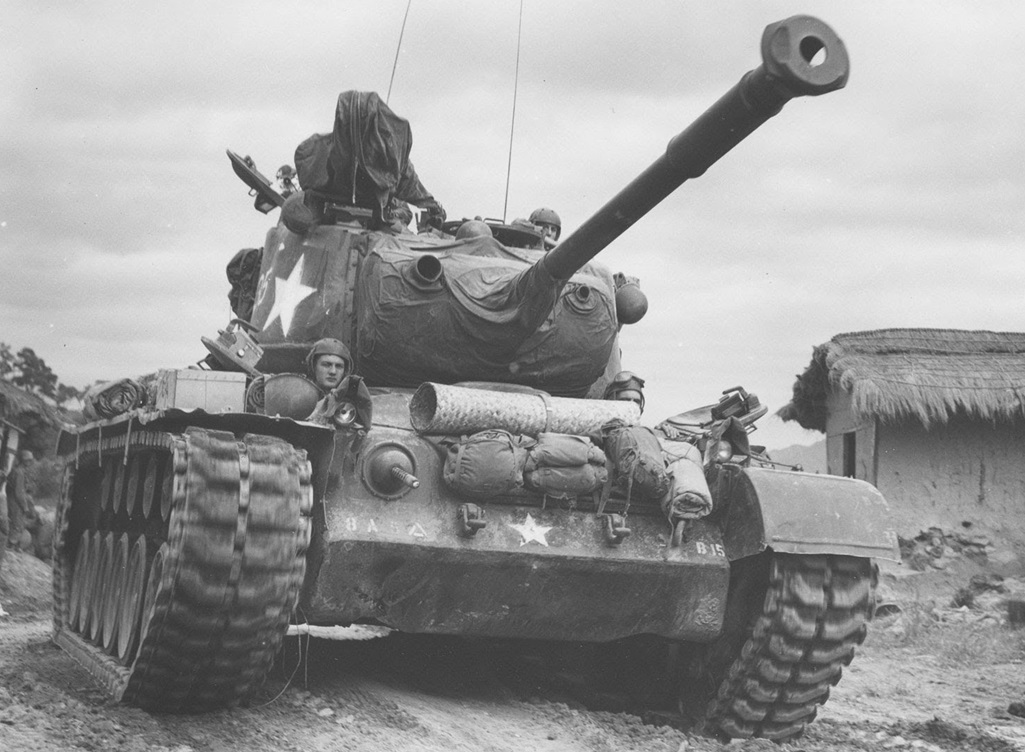






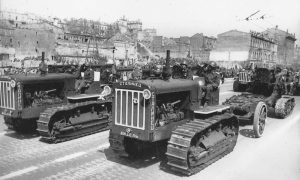







Pingback: FlaK 88mm, 18/36/37 Anti-Aircraft Gun - Real History Online
Bruce
December 12, 2022 at 7:25 pm
The M-26 was not introduced in numbers as Patton won out in the decision to use only the M-24 tanks. Patton foolishly believed that tanks were like horse calvary and there would never be a need for one of his tanks to take on a German Panther tank directly. The result was the complete failure of the November 1944 offensive by the allies and the unhindered retreat of the German armies from France. Patton’s decision not to use the M-26 that was faster, more fuel efficient, had far better armor and a far more powerful canon, resulted in the unnecessary deaths of thousands of infantry soldiers and many hundreds of tank crewmen. The alies lost so many tank crew that they could not train their replacements fast enough and started to pull infantry soldiers and stick them in tanks with less than a day of training. Even then the size of many tank crews were reduced from 5 men to only 3 men per tank.
Admin
December 17, 2022 at 1:59 pm
Thank you for your very well written and informative reply. You seem quite knowledgeable about the matter. If you would be interested in Guest Writing for our website and sharing your knowledge, we would love to have you onboard.
Pingback: T-34-85 Soviet Medium Tank - Real History Online